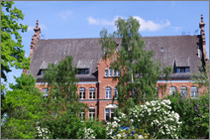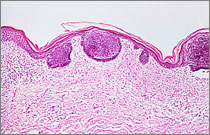Non-Hodgkin lymphoma
| 2020 | ||
|---|---|---|
¹ per 100,000 persons, age-standardised according to the old European standard population * calculated using the period method for 2019 / 2020 | ||
| Women | Men | |
| Incidence | 8,230 | 10,090 |
| Age-standardised incidence rate¹ | 11.0 | 15.9 |
| Deaths | 3,180 | 4,012 |
| Age-standardised mortality rate¹ | 2.9 | 5.4 |
| 5-year prevalence | 30,000 | 35,400 |
| 10-year prevalence | 50,700 | 58,100 |
| Relative 5-year survival rate* | 72 % | 71 % |
| Relative 10-year survival rate* | 68 % | 64 % |
Non-Hodgkin lymphomas are a heterogeneous group of cancers that originate from cells of the lymphatic system called lymphocytes. The various lymphomas differ in terms of prognosis and therapeutic options depending on cell type as well as clinical and molecular characteristics.
In 2020, approximately 18,320 people in Germany were diagnosed with non-Hodgkin lymphoma. The disease is typically diagnosed in persons of advanced age. On average, women were 73 years old at the time of diagnosis and men were 71 years old.
The increasing age-standardized incidence rates must be interpreted in the context of changing diagnostic criteria, since chronic lymphocytic leukaemia is now frequently classified as a non-Hodgkin lymphoma. The age-standardised mortality rates for both women and men declined in the first decade after the turn of the millennium and have remained at about the same level since then.

![]() Age-standardised incidence and mortality rates by sex, ICD-10 C82-C88, Germany 1999 – 2016/2017, projection (incidence) through 2020, per 100,000 (old European standard population)
Age-standardised incidence and mortality rates by sex, ICD-10 C82-C88, Germany 1999 – 2016/2017, projection (incidence) through 2020, per 100,000 (old European standard population)
The average prognosis for non-Hodgkin lymphomas is rather good overall, with relative 5-year survival rates of 72 percent for women and 71 percent for men, but mortality risk remains elevated throughout the course of the disease.
Various factors can increase the risk of disease
No single factor is known to influence risk of all types of non-Hodgkin lymphoma. A congenital or acquired immune deficiency, radioactive radiation, chemotherapy and some rare autoimmune diseases may increase the risk of certain lymphomas. Some pathogens are also considered risk factors for specific types of lymphoma. For example, the Epstein-Barr virus (EBV) can contribute to the development of Burkitt's lymphoma, which is endemic mainly in Africa. An infection with Helicobacter pylori bacteria plays a key role in the development of MALT lymphoma of the stomach.
Benzene and related substances can promote the development of specific non-Hodgkin lymphomas. Other environmental toxins and lifestyle factors are also being discussed as possible causes of lymphomas. Familial clustering of lymphomas may indicate an elevated lymphoma risk for unaffected relatives, but the precise connections are still unclear.
For many lymphoma patients, no clear cause can be identified. Presumably, several factors must interact before non-Hodgkin lymphoma develops.
Date: 21.03.2024






